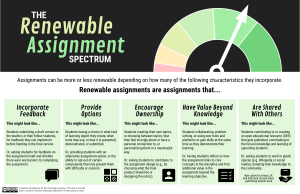Module 4: The Next Step
Key Content
Readings
Kathrina Schwartz, How Teacher Are Changing Grading Practices with an Eye on Equity
This article suggests several unconventional ways to bring equity to grading:
- Ending the “0” grade
- Grading on a 4.0 scale instead of a 0-100 scale
- Grading the best result rather than averaging performances across a semester
- Removing extra credit
- Removing compliance/behavior based grades (participation, homework, etc.)
Tony Winger, Grading What Matters
This article makes the case for focusing on competence rather than compliance in our grading. Winger, a high school educator, argues, “If we focus predominately on measuring students’ compliance and their ability to recall facts, our practices will interfere with our most significant purposes as educators. If we are to shift our focus to higher-level thinking, we must shift our grading practices.”
Amanda Grey, Building-in Student Buy-in: Disposable vs Renewable Assignments
Open Pedagogy expands the concept of Open Education, from instructor-generated and/or instructor-curated learning materials, to positioning students as content creators and curators as part of their learning journey. From the article: “In any given classroom, students range from ‘here for the credit’ to ‘here to learn as much as I can’ with the majority lying somewhere in the middle. While there will always be students who are unable to engage, there are many who can be enticed towards deeper participation when given the opportunity. Open Pedagogy can provide that opportunity.” Peruse Grey’s Renewable Assignment Spectrum infographic as a preview to the more detailed article:

Media and Other Resources
University of Washington Center for Teaching and Learning, Addressing microaggressions in the classroom
Creating an inclusive environment must be a proactive practice rather than a reactive one in order to establish a trusting, safe community where all students can learn effectively. This extensive resource on how to think about and proactively address microaggressions can help you consider how to design just such an environment.
Media Attributions
- What-is-a-Renewable-Assignment © Amanda Grey is licensed under a CC BY-SA (Attribution ShareAlike) license
